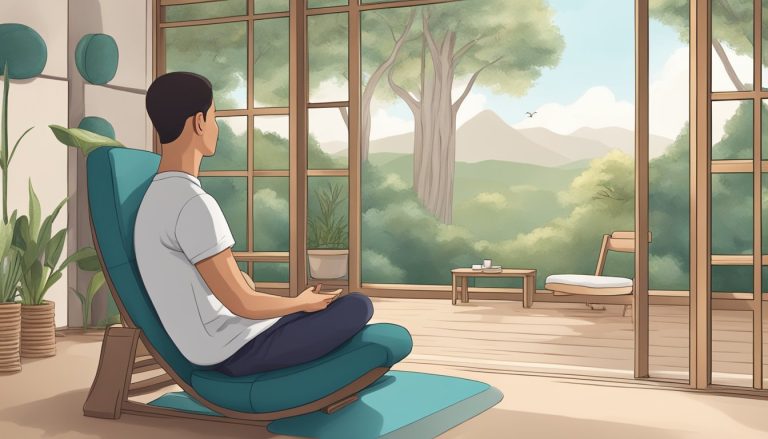How to Make a Meditation Eye Pillow: A Simple DIY Guide
Making a meditation eye pillow is a simple and enjoyable DIY project that can enhance your meditation and relaxation practices.
Eye pillows are often used during Savasana, the final relaxation pose in yoga, and can help reduce sensory stimulation, relax the muscles around the eyes and face, and promote deep relaxation.
In addition to meditation and yoga practices, eye pillows can also be used for nana-naps on bright, sunny days or whenever you need a quick break to relax and de-stress.

Choosing the right materials is an essential step in making a comfortable and effective eye pillow. The fabric should be soft and breathable, and the filling should be comfortable and soothing.
Some popular filling options include flaxseed, rice, lentils, and lavender, which have calming and relaxing properties.
Once you have gathered your materials, you can start cutting and preparing the fabric, sewing and assembling the eye pillow, and customizing it to your preferences.
Key Takeaways
- Making a meditation eye pillow is a simple and enjoyable DIY project that can enhance your meditation and relaxation practices.
- Choosing the right materials is essential for making a comfortable and effective eye pillow.
- Eye pillows can be used for meditation, yoga practices, nana-naps, and whenever you need a quick break to relax and de-stress.
Table of Contents
Choosing the Right Materials

When it comes to making a meditation eye pillow, choosing the right materials is crucial for a comfortable and effective experience. In this section, I will guide you through the process of selecting the perfect fabric and filling for your eye pillow.
Selecting Fabric
The fabric you choose for your eye pillow should be soft, comfortable, and durable. Natural fibres such as cotton, linen, and silk are great options for eye pillow fabric. These materials are breathable, hypoallergenic, and gentle on the skin, making them ideal for use during meditation or relaxation.
When selecting your fabric, consider the weight and texture of the material. A lightweight, smooth fabric will feel cool and refreshing against the skin, while a heavier, textured fabric will provide a more grounding sensation. Ultimately, the choice of fabric will depend on your personal preferences and needs.
Finding the Perfect Filling
The filling of your eye pillow is just as important as the fabric. The right filling will provide the right amount of weight and pressure to help you relax and unwind during your meditation practice.
Some popular fillings for eye pillows include flax seeds, rice, lavender, buckwheat, and beans. Flax seeds and rice are affordable and easy to find, while lavender and buckwheat offer a soothing aroma and added relaxation benefits.
When selecting your filling, consider the weight and texture of the material. A heavier filling will provide more pressure and grounding sensation, while a lighter filling will feel more refreshing and cooling. Again, the choice of filling will depend on your personal preferences and needs.
Cutting and Preparing the Fabric

Before we can start making our meditation eye pillow, we need to prepare the fabric. Here are the steps to follow:
Measuring and Cutting
First, we need to measure and cut the fabric. I recommend using cotton fabric as it is soft and comfortable against the skin. Using fabric scissors, cut two rectangles of fabric that measure 3.5 x 7.5 inches each. You can adjust the size of the rectangles depending on your preference.
Ironing and Pinning
Next, we need to iron and pin the fabric. Using an iron, press one of the short edges of each rectangle so that it is about 5mm above the wrong side of the fabric. This will create a hem. To create a double folded edge, fold it over again 5mm and press it with the iron. Repeat this process on the second rectangle.
Once you have created the hems, place the two rectangles with their right sides together, aligning the edges. Pin the sides and the bottom of the rectangles together, leaving the top part open.
Sew the two long sides and one short side using a 1/4 inch seam allowance, backstitching at the beginning and the end of each seam.
After sewing, trim the corners of the fabric to reduce bulk and turn the fabric right side out. Poke out the corners using a blunt object such as a chopstick or a knitting needle.
Congratulations! You have now cut and prepared the fabric for your meditation eye pillow. In the next section, we will fill the pillow with your choice of filling.
Sewing and Assembling the Eye Pillow
Stitching the Edges
To begin, I will take my pre-cut fabric pieces and place them together with the right sides facing each other. I will then use my sewing machine to stitch along three of the four edges, leaving one short edge open.
I will use a matching thread and a backstitch at the beginning and end of my stitching to ensure that the seams are strong and secure.
Once I have finished stitching, I will turn the fabric right side out and poke out the corners to ensure they are sharp and neat. Then, I will fill the eye pillow with my chosen filling, leaving about a quarter of the pillow empty.
Adding the Filling
For the filling, I will use a mixture of flaxseed and lavender to create a soothing and calming scent. However, you can use any filling of your choice, such as rice or beans.
I will then sew the open edge closed using a double-stitch to ensure that the filling does not spill out.
If you prefer a no-sew option, you can also try making a pouch using fabric glue or iron-on adhesive tape. This option is great if you don’t have access to a sewing machine or if you prefer a quicker and easier method.
Customising Your Eye Pillow

Making your own meditation eye pillow is a great way to personalise your meditation experience. Here are some ways to customise your eye pillow:
Incorporating Essential Oils
Adding essential oils to your eye pillow can add an extra layer of relaxation to your meditation experience. Lavender and chamomile are popular choices for their calming scents.
You can add a few drops of essential oil to the filling of your eye pillow or mix it with the filling before adding it to the pillow. Be sure to use high-quality essential oils and avoid using too much as the scent can be overwhelming.
Personalising the Design
Making your own eye pillow means you can personalise the design to suit your style. You can choose a patterned fabric or add embellishments such as sequins or beads.
If you’re making eye pillows as gifts, you can personalise them for the recipient by choosing a fabric or design that suits their taste.
Here are some ideas for personalising your eye pillow:
- Use a fabric with your favourite colour or pattern
- Add a monogram or embroidery to the fabric
- Use contrasting fabrics for the front and back of the pillow
- Add a ribbon or bow to the pillow for a decorative touch
Using and Caring for Your Eye Pillow

Proper Usage
When using your eye pillow during Savasana or any yoga class, place it gently over your eyes to reduce sensory stimulation and promote relaxation.
You can also use it at home for relaxation, or as a dream pillow to help you fall asleep faster.
If you experience headaches or fatigue, try placing your eye pillow in the microwave for a few seconds to warm it up. The heat can help soothe tension and promote relaxation. However, be sure to test the temperature before placing it over your eyes to avoid burning yourself.
When traveling, bring your eye pillow with you to help you relax during long flights or car rides. It can also be helpful for insomnia, as the weight of the pillow can help calm your mind and promote better sleep.
Maintenance and Storage
To keep your eye pillow clean, remove the cover and wash it in cold water with mild detergent. Be sure to let it air dry completely before using it again.
If you prefer, you can also make your own eye pillow cover using cotton fabric. Simply sew two pieces of fabric together, leaving one end open to insert the filling. Fill it with flaxseed, lavender, or herbs of your choice, and then sew the final end shut.
When not in use, store your eye pillow in a cool, dry place to prevent it from getting damaged. Avoid exposing it to direct sunlight or extreme temperatures, as this can cause the filling to lose its scent or texture.
Frequently Asked Questions
What materials do I need to create a DIY yoga eye pillow?
To create your own DIY yoga eye pillow, you will need fabric of your choice (cotton, silk, flannel, etc.), thread in a complementary color, scissors, and filling material (such as flaxseed, rice, dried lavender, or a combination).
Essential oils are optional, and you can also use ribbon or elastic to secure the eye pillow.
Could you guide me through making a no-sew eye pillow?
Yes, you can make a no-sew eye pillow by using fabric glue or iron-on hem tape.
Cut your fabric to the desired size, fold it in half with the printed sides facing each other, and glue or tape the edges together, leaving a small gap to fill with your chosen filling material.
Once filled, seal the gap and enjoy your no-sew eye pillow.
What are the steps to craft a lavender-infused eye pillow?
To make a lavender-infused eye pillow, you will need to add dried lavender to your filling material.
Simply mix the lavender with your chosen filling material and fill your eye pillow as usual. You can also add a few drops of lavender essential oil to the fabric before filling for an extra calming effect.
How can I make a weighted eye pillow for relaxation?
To make a weighted eye pillow, you will need to add a weight such as rice or beans to your filling material. Mix the weight with your chosen filling material and fill your eye pillow as usual. You can adjust the weight to your preference by adding more or less.
What’s the best way to fill an eye pillow for maximum comfort?
The best way to fill an eye pillow for maximum comfort is to use a filling material that conforms to the shape of your face, such as flaxseed or rice.
Fill the eye pillow to your desired level of firmness, making sure it is not too full or too flat.
How do I make a rice or flaxseed eye pillow at home?
To make a rice or flaxseed eye pillow at home, simply mix the rice or flaxseed with your chosen filling material and fill your eye pillow as usual.
You can adjust the amount of rice or flaxseed to your preference, but a good rule of thumb is to use equal parts of filling material and rice or flaxseed.






